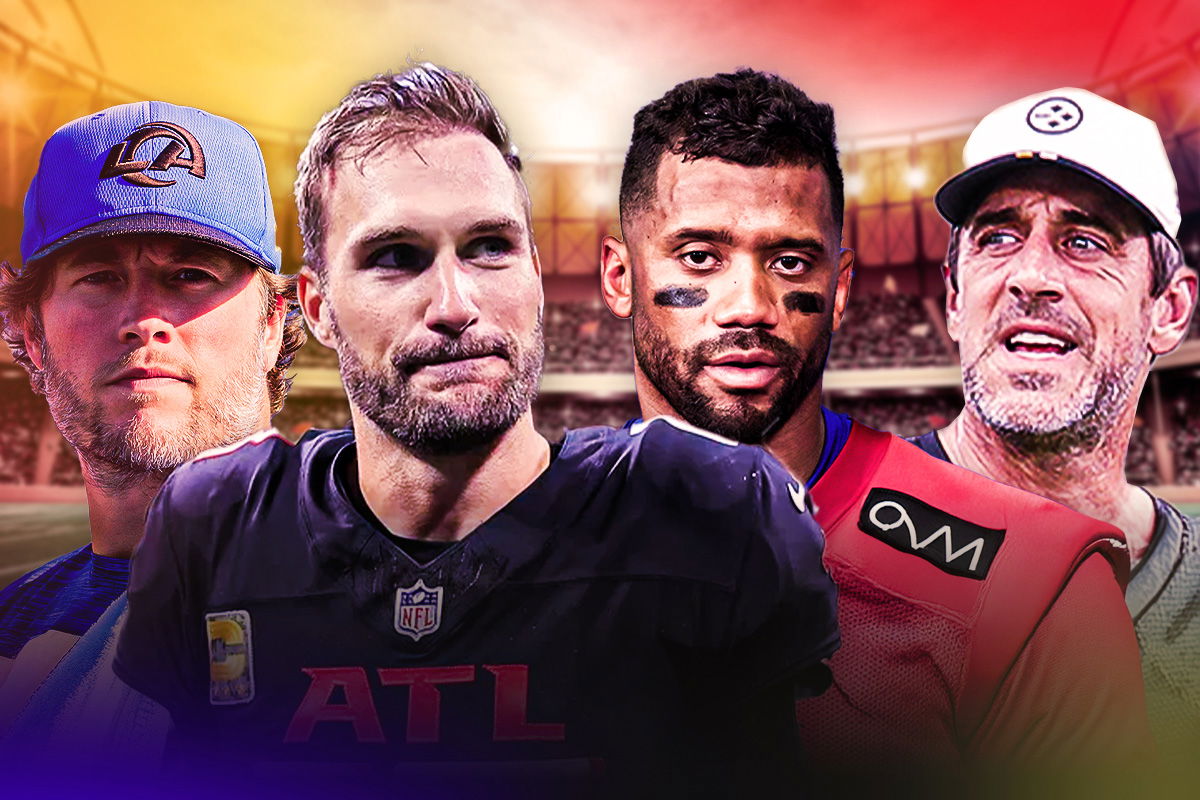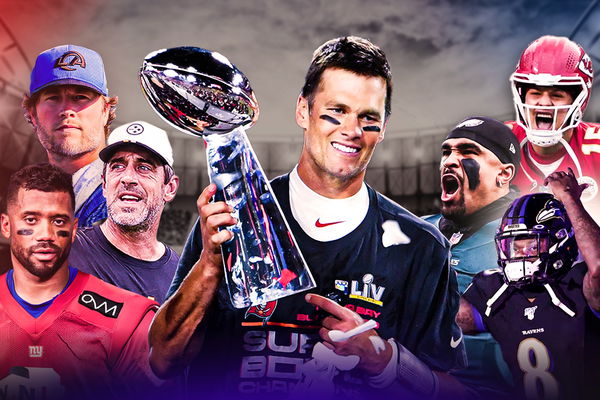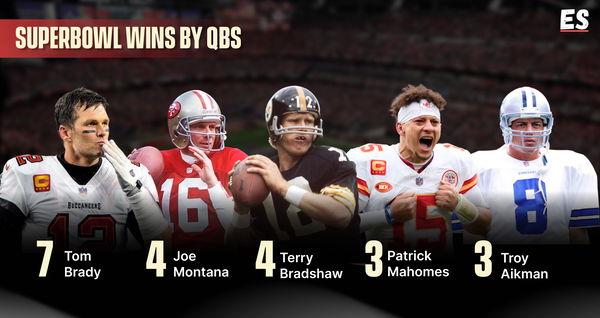
Imago
Credit : Imago

Imago
Credit : Imago
Tom Brady rewrote the rules of quarterback longevity, winning his first Super Bowl at 24 and his last at 43. For two decades, he outlasted rivals, adapted to new eras, and watched young phenoms like Josh Allen and Patrick Mahomes rise while legends like Peyton Manning and Drew Brees retired. Even now, as Jayden Daniels and Caleb Williams enter the league, no one has matched Brady’s sustained dominance. But from his era, a few survivors remain – Aaron Rodgers, Matthew Stafford, Russell Wilson and Kirk Cousins– all clinging to the NFL’s throne as a new wave of dynamic, mobile quarterbacks takes over.
Watch What’s Trending Now!
Lamar Jackson, Jalen Hurts, and now Daniels represent a seismic shift. Speed, creativity, and relentless athleticism are redefining the position. Meanwhile, Rodgers, Stafford, Cousins, and Wilson – once masters of precision and pocket poise – must prove they can still win in this league. So, can these veterans adapt their games, or are they the last of a dying breed? This isn’t just about age; it’s about evolution. Football tolerates tradition only until it loses. So as the 2025 season looms, we ask: Is this the final stand for the old guard?
ADVERTISEMENT
From gunslingers to greybeards: The rise, peak & pivot of the old guard
Aaron Rodgers, Matthew Stafford, and Russell Wilson arrived in the NFL like three chapters of the same story. Rodgers arrived first, drafted in 2005 – the same year Tom Brady won his third ring. But he sat behind Brett Favre for three seasons, a waiting game that sharpened his genius. By the time he took over in 2008, the NFL was still a pocket-passer’s paradise. Stafford followed in 2009, thrown straight into the fire as the No. 1 pick for a lifeless Lions team. His arm talent was obvious, but Detroit’s chaos meant his prime years burned in obscurity.
Wilson, the outlier, didn’t debut until 2012, a third-round steal who immediately changed the Seahawks’ destiny with his legs and clutch game. Then there was Cousins, the unlikeliest footnote to that 2012 class. Drafted 102nd overall by Washington – a baffling pick after they’d traded up for Robert Griffin III – he was an afterthought. No fanfare and no expectations. Just a clipboard and a long road ahead.
Rodgers was a magician, turning broken plays into art. No one extended drives like him, scrambling just enough to launch moon-shot touchdowns. Stafford was the iron-armed gunslinger, capable of fitting throws into windows that didn’t exist. For years, he carried Detroit’s hopeless roster, setting records (like 5,000-yard seasons) with no help. Wilson was the escape artist, a human Houdini in the pocket. His deep-ball precision and fourth-quarter heroics (‘DangeRuss’ mode) made Seattle a perennial contender.
ADVERTISEMENT
And Cousins? He became a quiet craftsman, unflashy, unshaken, and relentlessly consistent. While he never had Rodgers’ wizardry or Wilson’s theatrics, he mastered the mundane: surgical play-action passes, back-shoulder dots, and a knack for turning third-and-7 into automatic first downs. His career crystallized in Week 7 of 2015, during a game that would define him for years to come. Facing a 24–0 deficit against Tampa Bay, Cousins looked like a backup on the brink of being benched. Then came the explosion: 33 unanswered points, 317 yards, and 3 TDs, including a laser to Jordan Reed for the go-ahead score. As FedEx Field erupted, Cousins stormed the sideline and screamed, “YOU LIKE THAT?!” into a camera, a spontaneous roar that became his legacy. The clip went viral, embodying every underdog’s rage against doubters.
All three won exactly one Super Bowl – Rodgers in 2010, Wilson in 2013, Stafford in 2021 – but their paths couldn’t have been more different. Rodgers’ Packers built a powerhouse around him, yet playoff heartbreaks piled up. Wilson’s Seahawks leaned on the ‘Legion of Boom’ defense, but his career’s most unforgettable moment came in Super Bowl XLIX when, with 26 seconds left at the 1-yard line, the Patriots‘ Malcolm Butler intercepted his quick slant to Ricardo Lockette – a shocking call that still haunts Seattle fans a decade later.
ADVERTISEMENT
Kirk? The Lombardi Trophy eluded him entirely. Despite 12 seasons as a starter and four playoff trips (with three different teams), he never reached the Super Bowl. It’s a bitter truth that gnaws at his legacy. His closest brush came in 2017 when his Vikings fell one win short in the NFC Championship (a 38–7 thrashing by Philadelphia). Even his $180 million in career earnings and 40,000+ passing yards can’t quiet the ‘good stats, no rings’ critique.
Stafford, after 12 years in Detroit purgatory, got his ring only after escaping to the Rams’ loaded roster. Brady’s seven titles loom over them, but context matters. Rodgers never had a Belichick-level coach, Stafford wasted prime years on dysfunctional Lions teams, and Wilson’s Seahawks dynasty crumbled when the defense aged out. The difference between one ring and seven wasn’t just skill. It was luck, timing, and the surrounding team.
Their legacies are secure, but the present is precarious. Rodgers hobbles into 2025 at 41, that Achilles still fresh in everyone’s memory. Stafford’s dragging 37 years of NFL punishment in his wake – that cannon arm now more like a worn-out slingshot. Wilson, cut loose by Denver and Pittsburgh, clings to his late-career redemption tour, scrambling to prove he’s more than just a glorified game manager. Even Cousins, the model of mid-tier consistency, is now rehabbing a shredded Achilles at 36, watching Falcons’ bet on younger arms.
ADVERTISEMENT
Now, these old QBs are battling a league that’s rewriting the QB job description overnight. Lamar’s lightning strides, Hurts’ bulldozing physicality, and Jayden’s hybrid flair have turned the position into a track meet, leaving the old guard’s cerebral, stationary brilliance feeling like a relic. The question isn’t just whether these two can still play. It’s whether the NFL still has room for pocket poets in a dual-threat world.
The great QB divide
Football’s quarterback revolution has created a stark contrast between two competing philosophies of how to play the position. The veterans – Rodgers, Stafford, Wilson, and Cousins- represent the dying art of traditional pocket passing, where games were won through surgical precision and football IQ. Their careers have been built on reading defenses, perfect mechanics, and throwing receivers open with pinpoint accuracy.
ADVERTISEMENT

Imago
Imago
Then there’s TB12 – the GOAT, the ultimate outlier. Even as the league tilted toward mobility, the NFL’s oldest champion (43 at his final title) proved pocket passing could still dominate. Between ages 35 and 43, he won four more Super Bowls by refining his craft to absurd levels: releasing the ball in 2.3 seconds (faster than most scrambles), and turning boring check-downs into 12-play death marches. His 2016-2020 run with New England and Tampa Bay wasn’t just successful, it was a masterclass in adapting tradition to a dual-threat era without sacrificing his identity.
Meanwhile, the league now belongs to a new generation that has rewritten the quarterback job description. Mahomes, Jackson, Joe Burrow, and Hurts have transformed the position into something more dynamic – part passer, part playmaker, always dangerous. They combine elite arm talent with the athleticism to extend plays, turning what used to be sacks into explosive gains. Where the old guard would methodically move downfield, these young stars create magic out of chaos.
The results speak for themselves. At just 28, Mahomes already has three Super Bowl wins as a starting quarterback. That’s a milestone only four others (Terry Bradshaw, Joe Montana, Troy Aikman, and Brady) have reached in the 59-year Super Bowl era. Jackson’s unique dual-threat ability earned him two MVP awards before turning 27. Burrow took the Bengals from laughingstock to contender overnight with his clutch performances. And Hurts willed the Eagles to the Super Bowl. Not just with his bruising runs, but with a gravitational pull that reshaped entire defensive game plans. Defenders knew the snap might end with his shoulder lowering into their ribs, yet they still couldn’t stop the inevitable.

Imago
Imago
Yet for all their brilliance, this new wave has rewritten defensive playbooks entirely. Pass rushers can’t just crash the pocket. They’re now part-time detectives, forced to hesitate mid-stride as Lamar or Hurts evaporates from their grasp. Secondaries don’t just cover routes; they survive in coverage until the play’s third act, where receivers improvise and QBs turn chaos into TDs. Every snap is a chess match where the pieces move faster than the board allows.
So here’s the question haunting defensive coordinators today: In this track-meet era, is there still room for a pocket passer to thrive?
The numbers don’t lie: How QB play has transformed
The stats paint a clear picture of football’s evolution. Since 2015, quarterback rushing yards have exploded by 58% according to NFL Next Gen Stats – a number that would have been unthinkable in the Manning-Brady era. This isn’t just about designed runs. It’s about quarterbacks like Jackson, Mahomes, and Hurts turning broken plays into positive yardage when protection breaks down.
The league’s emphasis on quarterback safety has changed defensive play. Since 2018, stricter enforcement of roughing-the-passer penalties (up 27% per NFL data) and bans on dangerous hits (helmet-to-helmet, full-body weight landings) have forced pass rushers to alter their approach. These protections, while controversial, have given modern QBs both literal and figurative room to operate.
The pocket itself has changed, too. In 2010, quarterbacks averaged 2.91 seconds to throw. By 2023, that number dropped to 2.71 seconds – nearly a fifth of a second faster. That might not sound like much, but in football time, it’s the difference between a clean throw and a sack. Offensive lines now block differently, receivers run quicker routes, and the entire passing game operates at a faster tempo.
Perhaps most telling is how play-calling has shifted. Traditional play-action – long the staple of pocket passers – has decreased 11% since 2020. Meanwhile, run-pass options (RPOs) have surged 23% as teams look to exploit second-level defenders. The philosophical shift shows in modern play design. ESPN’s Dan Orlovsky explained in 2023: “Offenses now install ‘escape hatch’ concepts knowing protection might break down.” This aligns with NFL Network’s Bucky Brooks observing that “teams increasingly rely on QB playmaking after the initial read.“
While the NFL races toward athleticism, the cerebral quarterbacks of yesterday still hold unexpected advantages. Russ, Kirk, Rodgers, and Stafford enter 2025 with something their younger counterparts are still chasing: decades of defensive tells memorized like favorite playbooks.
Old school advantages in a new age game
The NFL’s obsession with speed and improvisation has turned QBs like Rodgers, Stafford, Cousins, and Russ into anomalies. Yet somehow, they’re still here, still starting, still winning games in ways that defy the modern blueprint. And then there was TB12. He was the exception that rewrote all expectations, a player so uniquely adaptable that he won championships in three different decades while the game transformed around him. There will never truly be another like him – a quarterback who could bend eras to his will while making immortality look routine.
As Hall of Famer Steve Young observed, these quarterbacks developed during a strategic sweet spot. A time when rule changes forced defenses to pull back, giving cerebral passers cleaner pockets and more time to dissect coverages.
Rodgers, for instance, turned those adjustments into a science in Green Bay, where his pre-snap audibles and lightning releases masked declining mobility. Stafford, even with a weakened deep ball, learned to carve up defenses with ruthless efficiency on third downs. Cousins, the perpetual pragmatist, compensated with clockwork precision on play-action. His 72.3% completion rate on those plays since 2020 is quietly among the NFL’s best. And Wilson, though never a traditional pocket passer, adapted by relying on veteran savvy rather than the scrambling that once defined him.
But here’s the irony: While their football IQ keeps them competitive, it hasn’t guaranteed postseason glory. Rodgers’ last Super Bowl run was in 2010—a lifetime ago in NFL years. Wilson hasn’t sniffed a title since the Legion of Boom disbanded. Cousins, for all his regular-season reliability, has just one playoff win in 12 seasons – a gut-punch reality for a QB with 40,000+ career yards. Stafford needed a super team in Los Angeles to finally win one. The league’s evolution has subtly worked against them; defenses now prioritize sideline-to-sideline speed to contain dual-threat QBs. And offensive schemes increasingly favor QBs who can create outside structure. Yet the old guard persists, proving that processing speed and anticipation still matter, even in an era that glorifies 40-yard dash times.
What’s fascinating is how they’ve adapted. Rodgers, when in New York, embraced quicker throws and heavier play-action to offset his limited mobility. Stafford’s Rams have leaned into shorter, timing-based routes to compensate for his declining arm strength. Wilson, after flaming out in Denver, reinvented himself in Pittsburgh by adopting a run-first offense that minimizes his exposure to pressure. Now, what he does with the Giants remains to be seen. Cousins, ever the pragmatist, quietly mastered the art of controlled aggression in Minnesota. He posted top-5 accuracy rates (69.1% in 2022) while reducing risky throws, a subtle evolution for a QB once labeled ‘Captain Checkdown.’
Still, the ceiling has lowered. For all their mental prowess, they’re no longer carrying teams the way Patrick Mahomes or Josh Allen can. The game has shifted. And while their experience gives them a stage most young quarterbacks lack, it doesn’t guarantee a high enough ceiling to win championships. They’re the last of a dying breed – bridge players between two eras, proving that old-school quarterbacking still has value, even if it’s no longer the dominant formula.
The ultimate question isn’t whether they belong. It’s how much longer they can walk the tightrope between decline and dominance. Their minds keep them in the fight, but the NFL’s physical demands never stop coming. Can Rodgers’ pre-snap sorcery outlast his body’s rebellion? Will Stafford’s battered arm and back hold up when January winds howl? And what of Cousins? Can a quarterback built on precision thrive in a league now obsessed with chaos?
For now, they remain fascinating case studies in longevity, each snap a high-wire act between past glory and present reality. But here’s what keeps us watching: In a sport that chews up and spits out even the brightest stars, could one of these old souls pull off a final, improbable masterpiece?
ADVERTISEMENT
ADVERTISEMENT
ADVERTISEMENT

